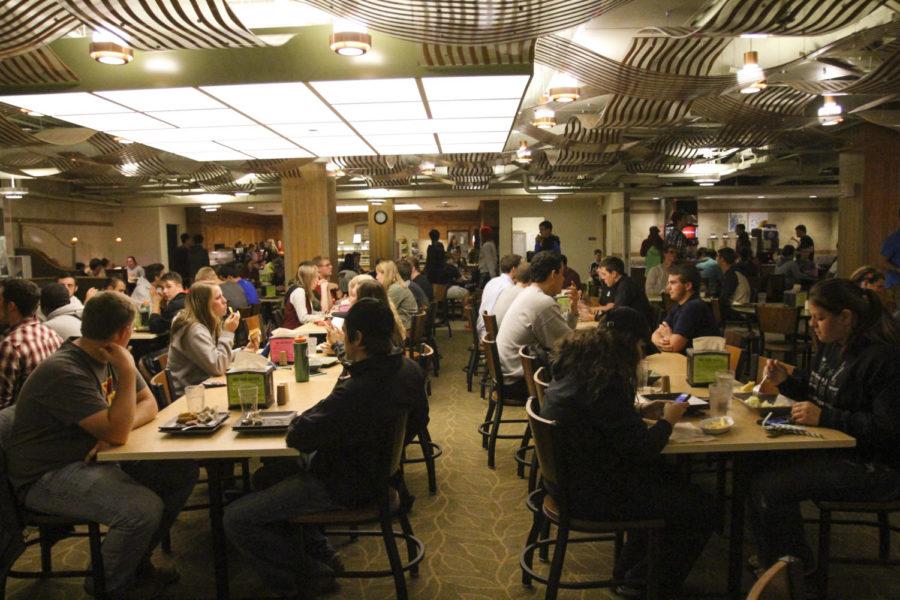GSB and administration look to solve issues from enrollment growth
Tiffany Herring/Iowa State Daily
President Steven Leath announced a 4.5 percent rise in enrollment on Sept. 10. For the 2014-2015 school year, Iowa State had its largest-ever enrollment of 34,732 students. The large enrollment number has led to overcrowding in places from dining halls to elevators.
December 5, 2014
Lines at the testing centers, three week waiting periods for health center appointments and traffic on Osborn Drive are things that majority of Iowa State students have had experience with this year.
The Government of the Student Body has proposed a resolution to university administration to address these problems for students.
Speaker of the Senate, Gabe Walsh, said that GSB senators held three working meetings to develop ideas that could eventually be proposed to administration. Three ideas that came out of the meetings were expanding the hours and staff of Thielen Health Center, increasing the seats in testing centers and eliminating traffic on Osborn Drive.
“It wouldn’t have been very powerful to send to administration ‘we want you to work on these 21 things’,” Walsh said. “We figured if we come up with three specific things that those would be three things that we wanted administration to take very seriously and things we’d like to see progress on.”
Once GSB senators reached a consensus on the three proposals that they would present to the administration, a resolution was sent to President Leath. Leath began working with his administrative staff on the feasibility of the proposals, one such member being associate vice president, Miles Lackey.
Lackey said the Iowa State administration wants to focus on enrollment issues in order to preserve the experience students expect to have. Lackey said some of the resolutions that were proposed were regarding things administrators knew needed to be addressed.
Administrators have started working on resolving wait times at the health center by increasing the hours of operation as well as increasing staff. Lackey said additional nurses and an interim physician for women’s health have been hired, and administrators are currently working to branch out to other local healthcare providers in the area.
Walsh said that some students are waiting as many as three weeks in order to be seen by a healthcare professional at the health center. He said that with students having that long of a wait leads to students not going to class due to their illness.
“We’re trying to get them to expand their hours of operation because obviously they aren’t able to meet the needs of students right now and that’s completely unacceptable,” Walsh said.
The second recommendation presented dealt with the lack of efficiency at the two testing centers on campus.
“People are upset that they are waiting four and five hours to get into the testing centers,” Walsh said.
Students have been complaining about computers shutting down during tests, issues with the tests themselves and issues with the test proctors. Walsh said that a lot of these problems can be attributed to overuse of the facilities.
Nick Allmon, a freshman in engineering, said that one of the biggest problems with the testing centers is that there are only two of them.
“A lot of times they are both full,” Allmon said. “If they’re both full at the same time I can’t get anything done.”
Tom Brumm, director of the ISU Testing Center, said testing center seats will be increased from 219 to 448 during finals week. By increasing the amount of seats, the testing centers will be able to accommodate 18,000 online exams.
“We’ve increased the staffing levels and IT support at the testing centers,” Lackey said.
Administration also will be developing a twitter account that will post wait times at the testing centers so students are able to know when seats are available.
“We’re trying to add additional seats and balance the load across finals week in multiple locations,” Lackey said.
The third recommendation GSB proposed was trying to eliminate some of the traffic on Osborn Drive and adding a bike lane.
Student safety is a priority and Allmon said that when he is walking near or across Osborn that he doesn’t feel safe.
“I feel like I’m going to get hit. Drivers are agitated when they’re over there. They don’t drive safely,” Allmon said.
Although Osborn is a concern to GSB and university administration, working to eliminate congestion will be an ongoing process.
“The health center and the testing centers [have solutions] that are a little more straight forward. With Osborn, we are studying that now,” Lackey said.
Administrators are currently working with the transit board to figure out ways to improve traffic-flow. Lackey said that discussions have come up about reducing the number and locations of bus stops on Osborn. GSB suggested building a parking ramp in order to avoid congestion as a viable option.
GSB and administrators are excited to work together in order to implement the plans they feel will benefit a vast majority of students at Iowa State.
“I anticipate and look forward to continuing that conversation with [the GSB]. Ultimately, we want to make sure that we continue to provide that student experience that our students expect,” Lackey said.

















